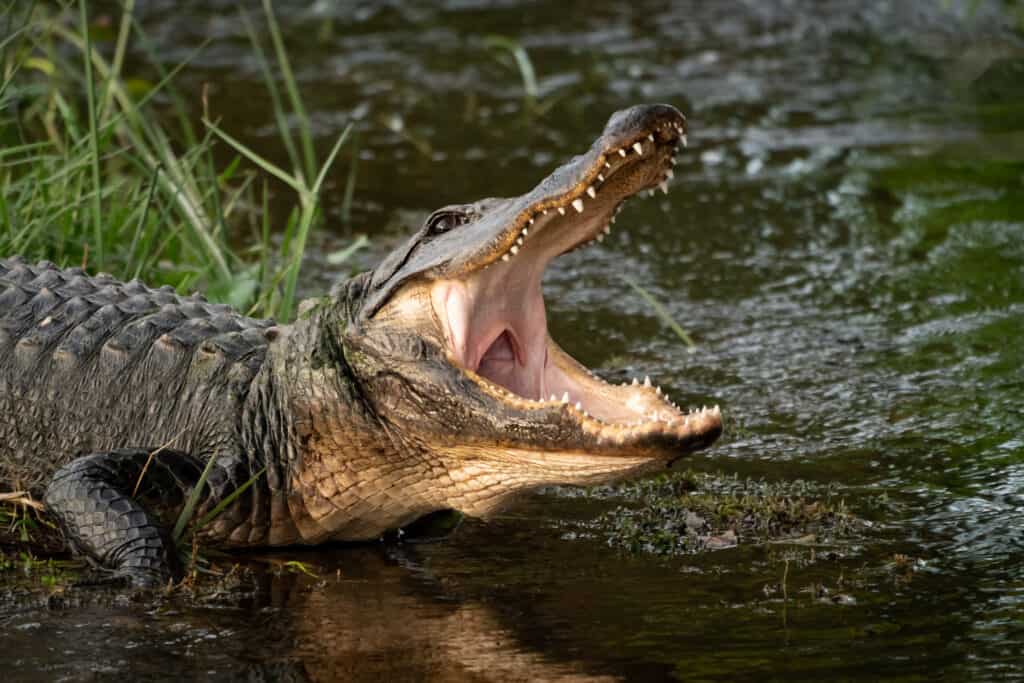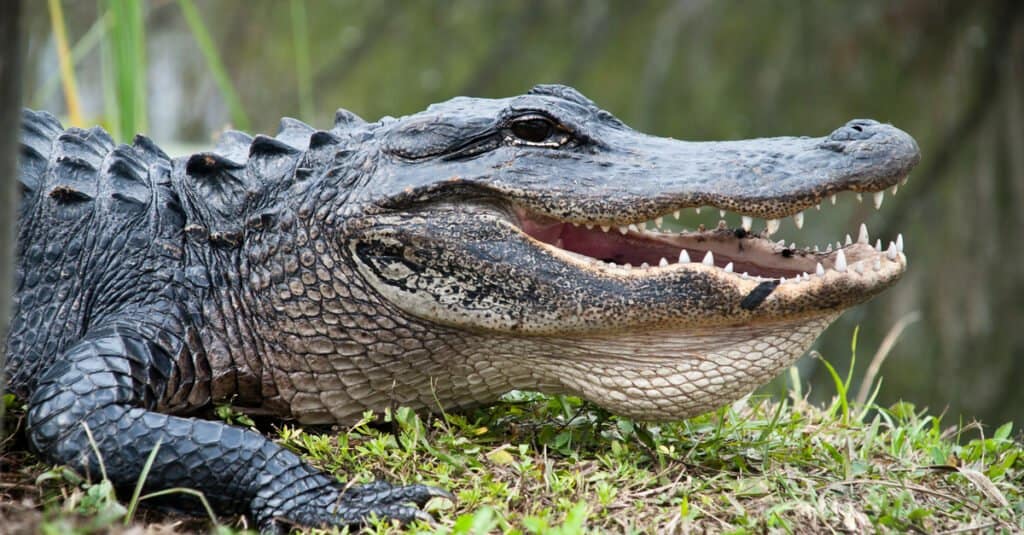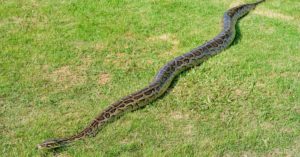Alligators just might be one of the most physically impressive reptiles on the planet. They’re also one of the largest, only ranking behind behemoths like the Nile and saltwater crocodiles. In the United States, the American alligator rules the swamps and lakes of southern Georgia. These creatures are native to the coastal, humid waters of the southern United States and can be found from Florida to Texas. But are there alligator-infested lakes in Georgia?
Here, we’ll discover what makes an alligator an alligator and whether or not they live in Georgia’s lakes. We’ll go over which parts of Georgia are home to alligators and where any alligator-infested lakes might be. Then, we’ll learn about the proper steps you should take if you encounter an alligator in Georgia and where you’re most likely to see these scaly monsters. Finally, we’ll take a look at a few things you should never do if you find an alligator-infested lake in Georgia.
Read on to learn more about alligators in Georgia!
What is an Alligator?

The American alligator, Alligator mississippiensis, is one of two types of an alligator.
©iStock.com/unclegene
Alligators are semi-aquatic, predatory reptiles in the Crocodilia order. They grow to an average of 8-15 feet and may weigh up to 800 pounds, though some specimens have grown even larger. Alligators in Georgia have thick, armor-like scales that tend towards dark green on the back and sides, with paler, less armored bellies. Unlike crocodiles, when alligators close their mouths, all of their teeth disappear into specially designed sockets.
Alligator-infested lakes in Georgia generally have a breeding population of alligators. All alligators start out life as eggs, emerging from their nests when they hatch. As youngsters, alligators are preyed on by all manner of creatures, including eagles, catfish, snapping turtles, and even other alligators. As the baby alligators grow, they become more and more formidable, with adults being able to capture and consume prey as large as deer and wild pigs.
Are there Alligators in Georgia’s Lakes?

Any standing body of water in Florida could house a gator, making swamps, rivers, lakes, and drainage pools all potentially dangerous.
©Deborah Ferrin/Shutterstock.com
Alligators live throughout the southernmost part of the United States; they’re common in Georgia, Florida, Louisiana, and Mississippi. There are alligator-infested lakes in Georgia; you just have to know where to find them. Alligators prefer warm, shallow bodies of water with plenty of food and cover. They tend to stay away from busy, urban areas, though they do sometimes stray into human-occupied bodies of water.
What Parts of Georgia have Alligators?

Alligators live in the southern part of Georgia, though there are occasional reports of ‘gators’ in the northern part of the state.
©iStock.com/Bradley Proxmire
If you’re looking to see wild alligators in Georgia, you might want to check out Okefenokee National Wildlife Refuge, also known as the Okefenokee Swamp. This large marshland is home to at least 10,000 wild alligators. It might not be an alligator-infested lake, but it’s one of Georgia’s most alligator-infested places.
Let’s take a closer look at one of the most notorious alligator-infested lakes in Georgia.
Georgia’s Most Alligator-Infested Lake

Lake Blackshear can be called the most alligator-infested lake in Georgia.
©RHMeeks/Shutterstock.com
Lake Blackshear just might be the most alligator-infested lake in Georgia, if news reports are any indication. It was there that, in 2019, the Department of Natural Resources (DNR) harvested a 700-pound, 13-foot, 4-inch alligator. The gator had been living in an irrigation ditch near the lake for about a week prior to the DNR’s involvement. Wildlife biologists identified the behemoth and determined that it was behaving strangely for an alligator.
On the scene, DNR officials discovered that the massive alligator seemed to be in extremely poor health, and made the decision to euthanize the animal. Once retrieved, wildlife biologists discovered that the alligator was suffering from several old gunshot wounds, which almost certainly contributed to its poor health.
Wherever this alligator came from, it spent its last days in one of Georgia’s most alligator-infested lakes. And, it’s one of the largest gators ever recorded in the state.
Where is Georgia’s Most Alligator-Infested Lake Located on a Map?
The most alligator-infested lake in Georgia, Lake Blackshear, is located in the southeastern section of the state – south of the city of Americus and northeast of Albany. The lake borders the town of Warwick to the south. Lake Blackshear borders five counties and contains approximately 8,700 acres.
Alligator Safety

Alligators are excellent swimmers and can hold their breath for up to two hours underwater.
©Willyam Bradberry/Shutterstock.com
If you plan to spend any time outdoors in the southern half of Georgia, it’s important to know a few basic rules about interacting with alligators. Let’s take a look at some of the most important things to remember.
Places You’re Most Likely to See an Alligator

Alligators spend most of their time either in, or near, the water, and may come out for any number of reasons.
©Wildnerdpix/Shutterstock.com
- Crossing the road.
- In the water.
- Near their nests (in the case of female alligators).
- Basking in the sun near a body of water.
- Approaching you for food (in the case of habituated alligators).
What Not to Do When You Encounter an Alligator in Georgia

Alligators are apex predators, and should not be taken lightly.
©RICIfoto/Shutterstock.com
If you happen upon an alligator in Georgia, there are a few key things you should avoid doing:
1. Never feed wild alligators. This leads to habituation in humans, which can lead both to human death and to alligator death.
2. Never approach alligator nests or baby alligators. Female alligators will act to protect their nests and babies. The last thing you want to do is enrage a mother alligator.
3. Never capture an alligator for a pet. Alligators might be cute when they’re little, but they don’t stay little for long.
4. Never harass or harm alligators. If you follow the above rules and stay out of alligator-infested lakes in Georgia, then you should have no reason to bother a wild alligator.
Honorable Mentions: Other Lakes with Alligators

While not technically a lake, the Okefenokee Swamp is the largest area of wetlands where alligators abound.
©Bob Pool/Shutterstock.com
If you’re wondering what other lakes could be inhabited by alligators in Georgia, look no further than the fall line. This invisible line runs from the city of Columbus (which lies on the western border of the state next to Alabama) east through Macon, ending in the city of Augusta. Any areas below that line can have alligators. Lake Blackshear, as well as the Okefenokee Swamp, sit below the fall line.
As discussed earlier, the Okefenokee Swamp has alligators. However, it’s not technically a lake. It’s a peat-filled wetland, or blackwater swamp that covers 438,000 acres. Typically, a blackwater swamp is a blackwater river, defined as a slow-moving channel that makes its way through forested swampland. The Okefenokee swamp, however, receives 95% of its water from rainwater. Two rivers do exit the swamp–the Suwanee River and St. Mary’s River. Interestingly, the water looks black but is in fact clear. The blackness comes from the peat that lies 5-10 feet below at the bottom. Within the swamp, there are over 60 named lakes. A few of the lakes within the swamp are Minnie’s Lake, Skull Lake, Billy’s Lake, and Monkey Lake. No matter how these bodies of water are labeled, there are an estimated 10,000-13,000 alligators within the massive swamp.
The photo featured at the top of this post is © jaimie tuchman/Shutterstock.com
Thank you for reading! Have some feedback for us? Contact the AZ Animals editorial team.







